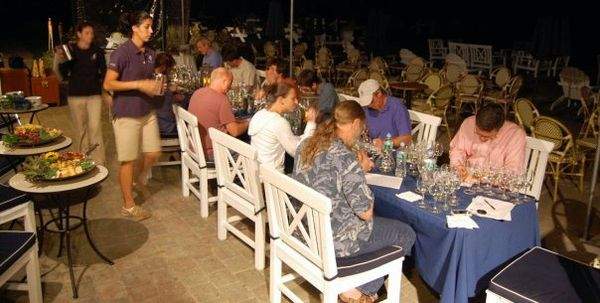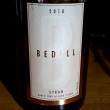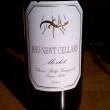TasteNY: Finger Lakes Riesling Results

The first TasteNY tasting at Peconic Bay Winery
By Lenn Thompson, Long Island Editor and Editor-in-Chief
As previously mentioned, I co-hosted a blind tasting of 24 rieslings (including 12 from the Finger Lakes) at Peconic Bay Winery last week as a part of the TasteNY project. It was a lot of fun and very interesting to taste these wines with 8 winemakers and some other members of the Long Island wine community.
The 24 wines were broken into three flights of eight wines each and were scored using the American Wine Society 20-point system and sheets.
Flight #1: Phillips Eckstein 2006 Riesling Kabinett, Billsboro Winery 2008 Riesling, Fox Run Vineyards 2008 Riesling, Grapes of Roth 2008 Riesling, Red New 2006 Dry Riesling Reserve, Paumanok Vineyards 2008 Semi-Dry Riesling, Sheldrake Point 2006 Reserve Riesling, Hermann J. Wiemer 2007 Dry Riesling.
Flight #2: Heron Hill Winery 2005 Old Vines Riesling, Peconic Bay Winery 2003 Riesling, Chateaux Ste. Michelle 2007 Eroica, Peconic Bay Winery 2007 Riesling, Domaine Schlumberger 2005 Riesling, Dr. Konstantin Frank 2007 Dry Riesling, Weingut Max Richter 2007 Riesling Kabinett, Osprey's Dominion 2008 Riesling.
Flight #3: Martha Clara Vineyards 2008 Riesling, Ravines Wine Cellars 2007 Riesling, Lamoreaux Landing 2008 Red Oak Riesling, Anthony Road Wine Company 2008 Semi-Dry Riesling, Palmer Vineyards 2008 White Riesling, Paumanok Vineyards 2008 Dry Riesling, Hazlitt 1852 Homestead Reserve Riesling, Atwater Estate 2007 Dry Riesling.
At the end of the evening, I collected all the scoring sheets and used my rudimentary Microsoft Excel skills to crunch the numbers a bit, dropping the high and low scores for each to arrive at adjusted averages for the wines. Here are the top 10 scoring wines and their score out of 20 possible points:
Phillipps Eckstein 2006 Kabinett 14.9 Lamoreaux Landing 2008 Red Oak 14.85 Weingut Max Richter 2007 Kabinett 14.722 Anthony Road 2008 Semi-Dry 14.67 Billsboro 2008 14.3 Atwater Estate 2007 14.05 Paumanok 2008 Semi-Dry 14 Red Newt 2006 Dry Reserve (tie) 13.6 Sheldrake 2006 Reserve (tie) 13.6 Eroica 2007 13.4
Just out of the top 10 was a cluster of Long Island wines amongst the next five highest scores (with two well-known Finger Lakes producers):
Palmer Vineyards 2008 13.05 Martha Clara Vineyards 2008 12.95 Peconic Bay Winery 2007 12.83 Osprey's Dominion 2008 12.8 Paumanok 2008 Dry (tie) 12.75 Dr. Frank 2007 Dry (tie) 12.75 Fox Run 2008 (tie) 12.75
So what did we learn? I think a few things:
- Long Island riesling can more than hold its own. I'll admit it, I was surprised at how well the Long Island wines fared. Pleasantly so.
- Winemakers are fun to taste with — but hyper-critical. Taking the winemakers out of the data didn't significantly impact the wines appearing within the top 10, but it did impact the average scores. With winemakers, the top adjusted average was 14.9. Without them, the lowest score in the top ten was 15.5 and the highest was 18.5.
- The winemakers did not like the Peconic Bay 2003. The biggest change in the wines between the groups was for the Peconic Bay Winery 2003 Riesling, which received an average adjusted score of 18 from the non-winemakers. It received a 10.83 adjusted average from the winemakers.
I also know from talking to several of the winemakers at the table that they thought that the Lamoreaux Landing was something other than riesling (sauvignon blanc was the most mentioned). That is also reflected in the scores. It was the non-winemakers' favorite wine overall but was in the middle of the pack for the winemakers.
By the way, there were 8 winemakers tasting and 4 non-winemakers.
Ignoring the numbers themselves for a minute and just looking at the order to choose "favorites" we have:
Overall Favorites:
- Finger Lakes: Lamoreaux Landing 2008 Red Oak Riesling
- Long Island: Paumanok Vineyards 2008 Semi-Dry Riesling
- Other: Phillipps Eckstein 2006 Kabinett*
Winemakers' Favorites:
- Finger Lakes: Anthony Road Wine Company 2008 Semi-Dry Riesling
- Long Island: Martha Clara Vineyards 2008 Riesling
- Other: Phillipps Eckstein 2006 Kabinett*
Non-Winemakers' Favorites:
- Finger Lakes: Lamoreaux Landing 2008 Red Oak Riesling*
- Long Island: Peconic Bay Winery 2003 Riesling
- Other: Chateau Ste. Michelle 2007 EROICA Riesling
* Overall favorite within the grouping
I know that I've only offered a little analysis here, but hey, I'm a blogger, not a statistician. It's been a long time since that bio-metrics/statistics course in undergrad.
Once again, I'd like to thank Peconic Bay Winery for hosting us, the winemakers and other industry folk who joined us and to all the Finger Lakes wineries that participated in the TasteNY project.
Next up? What do you think about Long Island merlot?
















Great stuff. Several points:
1) Was the Ravines actually the ’07, or the ’06 Dry? I know some packs got the ’07.
2) Did you detect as much grilled fennel in the Anthony Road as I did? That is an outstanding wine. It’ll be fun to see it age.
3) I’m very much looking forward to trying some Long Island Riesling on my upcoming trip.
4) Long Island Merlot sounds great… followed by New York state Cab Franc, right? With Cab Franc from all regions - right? (Can you tell the NYCR is packed with CF fanatics?)
5) I really, really need to pin down my tasting for this. Heh.
Evan:
1) We had the 07 Ravines.
2) My notes (as well as those from the group) are at home.
3) We’ll make that happen.
4) If I didn’t think I’d get tarred and feathered by my locals, we might be doing cab franc next.
5) You sure do.
Were the chairs at Peconic Bay really uncomfortable or something that the winemakers scored it so low?
A very interesting tasting Lenn - thanks for putting this together. Both the Finger Lakes and Long Island producers should be very proud of their work!
I think another event you should consider is a tasting of some older Long Island reds (10 years +) - merlot, franc and cab sauvignon…
wow, I would love to drink those spit buckets.
Rich, you read my mind. I just sent you an email on the older reds piece. Not for TasteNY though.
I agree that winemakers I’ve tasted with often tend to look for faults, but hey, that’s kind of their job, right?
It’s absolutely their job. Eric Fry told me that night that unless he has an amazing, complex plate of food in front of him, he can’t just DRINK and ENJOY wine.
It’s why he drinks beer. Wine is work.
Just for the record, not all winemakers feel this way
I should also point out that the absence of fault is not necessarily the presence of greatness.
Would have been nice to see a Long Island Riesling crack the top 5. It’s good to see that NY has some great Riesling.
These suggestions and ideas for the future has my head spinning.
Well done Lenn, I am sure this took up a huge amount of time. I personally appreciate it.
Thanks, Michael. Consider this your invitation to the next one.
Hopefully in December/January timeframe.
And I know you’re a Fellow Franc Fanatic…so there will be one of those coming too.
Lenn- Did I miss who the 8 wine makers tasting were?
FOLLOWUP:
Lenn gave me the raw data (made anonymous and grouped into winemakers or trade folks) and I did some further analysis.
I took the values of winemakers and non-WM and performed Student t-tests. This test basically says “given the average and the standard deviation (i.e. the variability) and number of samples, are these values statistically significantly different?” For example, if i had 2 groups where the averages were 3 and 4, you’d think that group 2>group 1. But if the standard deviation was all over the place (3 +/- 2 and 4 +/- 1), then they would not be significantly different, since values might overlap.
Let’s look at Lenn’s conclusions in this light.
1. Long Island held its own:
A t-test between wines grouped as FLX vs. LI showed no statistically significant difference between the LI scores and FLX (p=0.39) for both raw and unadjusted data. However, if you take the top 8 FLX vs. the 8
LI, it is significant (p<0.001) and the Finger Lakes scored better. Can’t read too much into this though, since the FLX were hand-selected and it seems like the LIs are more of a random sampling.
Across the board, vs. FLX they held up, but against the top 8, FLX were better. Looking at ranking, though, you can sort of make that conclusion. Basically, this panel liked some FLX a lot and didn’t like some FLX, but the LI was consistently good. If you drop the bad FLX, the good FLX win over LI as a whole. I know this wasn’t set up as a LI vs. FLX competition, but Lenn brought it up.
2. Winemakers are hypercritical:
With this small of a sample, it’s hard to make such a broad conclusion, but let’s look at THESE winemakers in THIS instance.
If you average all the scores, winemakers and trade folk scored statistically significantly differently:
winemakers (12.2 +/- 3.4) vs. trade (14.4 +/- 3.3), with winemakers slightly more critical overall.
3. Winemakers don’t like Peconic Bay 03.
Well, they did score it differently, statistically significantly.
Let’s look at individual wines:
Using the raw data (unadjusted, since if you subtract hi and lo the sample size for the trade is 2), I compared the mean/stdev/n for both groups for each individual wine. 5 total wines were statistically significantly (95% confidence, p<0.05) lower with winemakers than trade folk:
Lamoreaux Landing Red Oak
Ravines 07
Hazlitt 08
Eroica 07
Peconic Bay 03
At a 90% confidence interval (p<0.10), Wiemer and Grapes of Roth are also differently scored.
What would be interesting is if these 5 shared some unique characteristic (i.e., all dry, all sweet), but I doubt it. Maybe certain flaws showed up in these 5 that the trade folks are not trained to pick up (i.e., too much SO2, reduction, etc.)? It would be interesting to see that in the comments. The fact is, something about these wines in particular made winemakers and non-winemakers score them differently.
So generally, Lenn’s cursory analysis is right on the mark. However, by diving deeper into the data, and by considering the variance in scores, we can fish out even more information!
I should note that an inherent assumption of the t-test is that the data fall into a gaussian distribution. With 12 people, it’s tough to say whether that’s true without looking at each histogram, so take this very small sampling with a grain of salt.
Overanalyzing makes it sound as though there is a scientific way to discern what is inherently personal preferences and different palate perceptions. If it was scientific there would be unanimity in tasting, which is never the case.
My conclusion is that this tasting confirms that a strong suit of the Finger Lakes is Riesling. And Long Island, which is better known for the diversity of its varietals, happens to make very good Rieslings too.
Charles,
But that “…strong suit…” and LI “…happens to make…” remain within the context of this single tasting.
The only possible way a definitive statement can be made is when such results are replicated, and with FL Riesling that has been happening over and over, and over the years. Frankly, I don’t know why people are still testing the theory.
What the FLakes region needs now is not more tastings but quality PR and marketing programs.
Surely everybody’s got a different palate, but this isn’t the first time that I’ve seen winemakers score wines lower than trade folk. Is that because they have more wine experience in general? Who knows?
The wide variation in winemaker scores (25%) shows that even winemakers don’t score uniformly, and this is probably largely based on personal preference.
I don’t think that “scientific” and “diverse” are opposites.
Thomas,
All of NY needs good promotion. It is not FL versus LI but NY versus our absence in the psyche of the wine consumer.
Unfortunately on LI we are not united and we have no leadership to project a stronger image. It is left to individual wineries to carry the flag, and we are having enough success that I am preaching that we should stop playing victim and project greater confidence that goes with the current market penetration.
I do not know how united the FL industry is and how good a leadership exists. This is an opportunity for an organism such as the NY W & GF to display some positive leadrship and put NY on the wine map. Unfortunately that entity is too stuck in its ways and is ineffective for what is needed.
One more reason to not rely on anyone but ourselves to get our story out.
Thomas,
You say “What the FLakes region needs now is not more tastings but quality PR and marketing programs.”
The Finger Lakes and the entire state of New York are at a competitive disadvantage against other more established regions because of limited budgets. There IS very much a quality PR and marketing program in place and much of that program lies in getting as many media, trade, and consumers tasting the wines. There are still many people in the wine industry that aren’t familiar with the overall quality and value coming from the Finger Lakes.
The region submits wines to Wine Spectator, Wine Enthusiast, and Wine & Spirits at least four times a year (to each publication.) We also send wine samples to another highly targeted list of wine writers and bloggersm including the New York Cork Report. In the past couple of weeks at least four Finger Lakes wines were Wine Spectator wine picks of the day. Dr. Konstantin Frank is up for American Winery of the Year by Wine Enthusiast and both Hermann J. Wiemer and Sheldrake Point Vineyard were selected this year as Top 100 Wineries in the World by Wine & Spirits.
We attend the major wine expos each year: New York, Boston, and Washington DC and host a trade and media Riesling tasting each spring in New York City.
We host wine and travel writers to the region. This past month alone we hosted Patrick Comiskey from Wine & Spirits and Rod Phillips from the Otttawa Citizen.
We are aggressive in the social media world with a strong presence on Twitter and Facebook to connect with media, trade, and consumers.
In the end, what is limiting the exposure for Finger Lakes wine is not a lack of PR or marketing efforts but a lack of national distribution, small Riesling production (under 100,000 cases), and limited marketing budgets at both wineries and associations.
Charles,
Hear, hear.
Morgan,
I’m not going to get into specific PR and marketing discussions here-and not without some remuneration either.
Referring to what Charles said about the NYWGF: the organization has had access to about $1 million a year for about 25 years!!! How limited is that budget?
After all those years, one would think that the NY wine message would have been solidified, dispersed, and showing more powerful results by now.
Morgen,
I have to agree with Thomas. When we had all the money that Governor Paterson cut, we were still complaining that we did not have enough money.
If we pool all the money that all the wine trails and the NY W & GF spend collectively it is plenty to get a high quality PR firm do a better job than such successful campaigns as the Wines of Germany, the Wines of Chile and such have waged. Unfortunately it is all parceled out to redundant jobs and hardly anything is left to do the actual work.
The money is there and when we show some positive initiatives we will probably be able to raise more. But if each trail insists on replicating the others and the NYW&GF continues to march to its own drums then we have exactly what we deserve.
Thomas and Charles,
I agree that more can be done to pull the regions of New York together. I was speaking previously in the context of the efforts of the Finger Lakes. I believe instead of complaining about the lack of efforts from the NYWGF the regions can do more to work together and the upcoming December 6th New York City wine event at City Winery is a good first step. (The details of this event will be coming out shortly from the NYWGF).